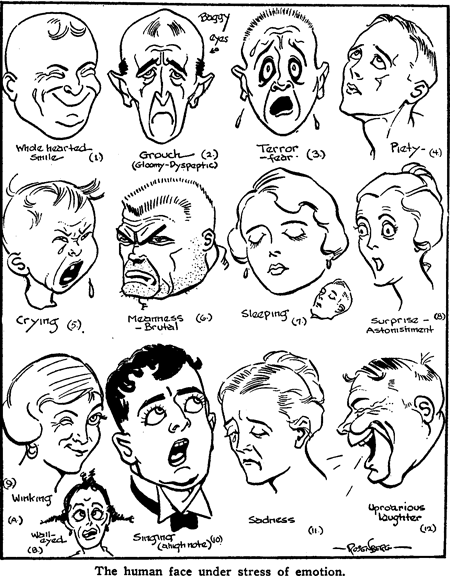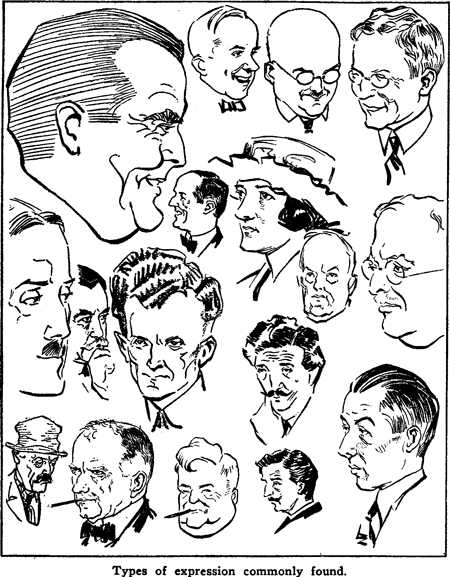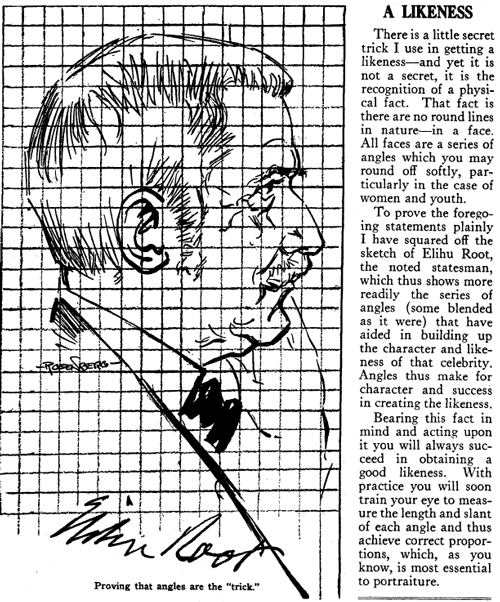Home > Directory of Drawing Lessons >How to Draw People > Drawing Facial Expressions > How to Draw Human Facial Expressions and Emotions in Your Portraits
Drawing People's Faces and Their Facial Expressions and Emotions : How to Draw Facial Expressions in Portraits
|
GETTING PORTRAIT VALUES : How to Put Expression in the Face
The ability to draw the human figure, while a great accomplishment, is, however, of little avail unless one also can give portrait values—expression and character—to his subjects. The following pages, while in the nature of the case they cannot be made exhaustive, yet will give the student valuable hints that, with constant practice and study, will enable him to gain facility in this direction.

Picture # 1
Note the first face in the illustration above—smiling, grinning, joyous. This expression is attained simply by turning upward the corners of the mouth. The cheeks naturally are raised by this action, and the eyes are often half-closed (in some persons completely) when the subject is "smiling all over." The inner corners of the eyes slopes down. The outer end of the eyelid, in adults, fuses into a furrow that seems to extend in some cases over the cheek bone, often for two or three inches. In adults past middle age, there are additional lines running out in pronounced joyous expression in the same region as the furrow, but in various outward directions. These lines are called "crows' feet." They should rarely be added to a feminine face, since to the reader they may suggest age.
The eyebrows are arched, with a tendency to droop lower on the outside than the inside end. In most faces there is a dimple, or a cheek furrow. This furrow in some extends from the cheek center on a line with, or somewhat above, the nostrils, tapering vertically toward and to the sides of the chin. A "smile" can even be suggested by the hair, by means of turning the strands softly upward. Usually the best subject for a smile is a fat man. He is popularly supposed to be jollier than a thin man, his digestion usually being better.
Picture # 2
No. 2, however, is dyspeptic, grouchy, pessimistic. A dyspeptic condition turns the corners of the mouth downward; it produces a "long face." The lines of the cheek muscles are made to extend almost straight downward and slightly outward, converging at their base. The eyebrows and eyes slant towards the center. The nose usually is dropped below the nostrils.
In older faces, sharply defined lines extend downward from the eye. The cheeks are hollow and the brow cramped, warped, furrowed and wrinkled. There are puffs beneath the eyes. Between the eyebrows in adults the lower portion of the forehead is furrowed, with one, two or three lines. The nose is usually long, thin and well defined. This type of individual is so constantly distressed and unnerved that his hair becomes thin and often he becomes partially bald before he becomes gray. He is usually thin, emaciated, and long faced. The head often tapers vertically from the pate towards the chin.
Picture # 3
No. 3 shows worry, fear, and even terror. The eyes are opened wide and the pupils, diminished, stare forth from about the middle of the eyes. The eyebrows take an upward turn from and towards the inside. This contraction creates furrows between the eyebrows. Dark rims often seem to form around the eyes, particularly below, over the pouch.
The nostrils and nose lobes become distended. The mouth is usually agape, the terror-stricken subj ect seeming to gasp for air. Again, the mouth may be tightly closed and the lips compressed. The subject fears to emit a cry that might expose him. The cheek lines converge inwardly at a bit below the line of the mouth.
Picture # 4
No. 4 expresses piety, and sometimes an affected sadness. The head is usually thrust backwards at a considerable angle. The eyes are sometimes open (sometimes completely closed, as during prayer or grace), and the cornea, the circle containing the iris and pupil, is brought upward to the upper eyelid. The eyebrows extend vertically upward toward the center—not necessarily in a completely straight line, but at the center, with the eyebrows turned slightly upward.
There may be, though not necessarily so, perpendicular furrows in the lower part of the forehead (between the eyebrows). In aged subjects there are natural furrows and wrinkles in the forehead. Remember to use lines, and especially those lines which express age. One would hardly put similar lines in the countenance of a youthful minister or church-goer. The lips may be slightly apart, if the subject is praying. With the head thrown back the nostrils become more prominent. Note also that the large jugular muscle of the neck and the Adam's apple becomes more pronounced. The cheeks are sometimes noticeably sunken in this posture of the head.
Picture # 5
No. 5 shows weeping, shrieking, hysterical sorrow. The facial muscles seem to screw up about the central base of the forehead, between the eyes. The baby's mouth is widely distended in emitting a howl of distress. The eyes are drawn downward and inward, closer together, and often completely closed. Tears flow out of the corners of the eyes.
The nose lobes are compressed, defining more prominently the furrow between this muscle and the lobes. The eyebrows arch, and have a tendency to turn upward a bit from the inner ends. The cheeks are compressed, the cheek line being similar to that in fear. The mouth is usually broader below than Above the center. The hair is apt to be dishevelled, and but one deep, horizontal furrow seems to form in the forehead--though frequently none at all. A furrow, near the base of the frontal bone, about the center, forms vertically, extending almost to the center between the eyebrows, the eyebrows moving closer to the center.
Picture # 6
No. 6 depicts meanness, brutality. On meeting a character of this sort in a dark, lonely spot one's countenance might likely duplicate the expression on face No. 3—certainly not face No. 1. The satanic eyebrows trend at a downward angle towards the center and seem to meet. The forehead is deeply and coarsely wrinkled, the wrinkles and furrows turning in and downward. The nose starts off from the depressed eyebrows with a wrinkle. It is usually small and pugged, with a tendency to turn upward, thus accentuating the distended nostrils. The corners of the lips are sharply turned down and inward. The upper lip is ofttimes hidden by the protruding under lip. The jaws are heavy and strongly defined.
The ears are apt to be small, and often are "cauliflowered." The hair is stubby, and the forehead very low—the lower it is, the more brutal the head appears. The eyes come close in towards the center and the eyebrows seem to lean over them. The neck is thick, and a dotted, lined stubble over the face increases the brutality of the countenance.
Picture # 7
No. 7 shows sleepiness, drowsiness. The eyes are closed, the upper lid covering the optics. The lashes extend noticeably slightly downward, curving upward towards the ends in some cases. In most cases the corners of the mouth relax slightly, or drop perceptibly. The eyebrows are arched. In true slumber the face is in repose. If the subject is dreaming the countenance will often give a hint of the dream.
Picture # 8
No. 8 illustrates astonishment, surprise. When you are surprised you "wake up" to whatever astonished and surprised you, and your eyes open wide and wider as your surprise grows. The eyebrows are elevated and create wrinkles above them. These wrinkles should be made thinner than the eyebrows. The cornea staringly centers between the wide-opened eyelids, and is separated from them by the seemingly enlarged white of the eye.
Picture # 9
No. 9 shows winking and blinking. The eyelid muscles are contracted. The winking eye is closed, or almost so. The center line, where the lids meet, becomes arched and the lower lid extends inwardly upward, turning downward near the inner end. The corner on the active side of the mouth turns upward as the cheek muscle of that side joins somewhat involuntarily the eye muscles sympathetically connected with the mouth muscle. No. 9 is of a cross-eyed countenance, indicating strabismus, due to certain physiological conditions. When one or both eyes turn inward, the patient is cross-eyed; when outward, "wall-eyed." Unlike any other crippled condition of the human anatomy, these ailments are always cause for merriment. In these cases the rest of the face also seems to lack symmetrical beauty.
Picture # 10
No, 10 depicts a person singing a high note. In singing the mouth is rounded, according to the vowel note being sung. The upper lip is drawn upward, exposing the teeth, and permitting a fuller note to pour forth. The eyes may wander and the eyebrows turn in to help express the artist's mood.
Picture # 11
No. 11 depicts sadness, weeping, sorrow. Crying in children is not so much due to sadness as to the fact that they want something they can't have. Sadness, on the other hand, is a sentimental expression of loss. The eyebrows trend upward. Wrinkles are not immediately created. However, they will develop with prolonged sorrow, which has a tendency prematurely to age one. A perceptible furrow is created in the forehead between the eyebrows. The eyes are usually downcast.
Picture # 12
No. 12 indicates laughter, hilarious joy. The general principals for drawing are as in No. 1. This is an exaggeration of the first face. The exaggeration is shown by the wide-open mouth— lip lines running upward and the upper teeth exposed. The other plate on the same page is of a group showing a variety of expressions. They are all sketches from life. One subject, in the lower left corner (showing concentration), is a noted turfman. Other heads are of actors, defendants in court cases, a divorcee, etc.


Privacy Policy .... Contact Us




